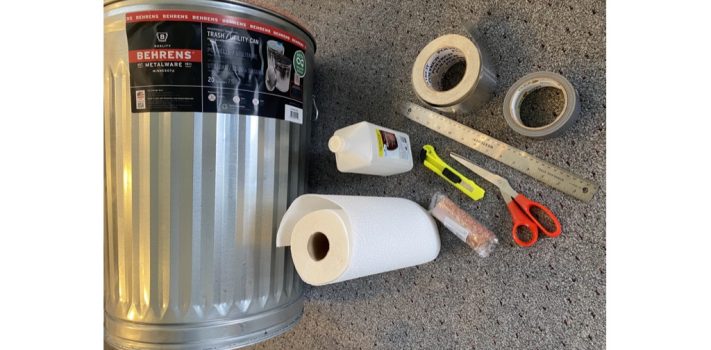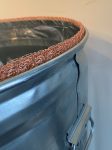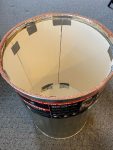This article describes the effects of EMP and CME and how to build a simple inexpensive Faraday cage.
Most readers of the SurvivalBlog are aware of the potential damage from either a Coronal Mass Ejection (CME) or an Electromagnetic Pulse (EMP) and the impact on everyday electronics. With an EMP, an electromagnetic pulse is generated at high altitudes from a nuclear explosion damaging sensitive electronics. A CME damages electronics in a similar way with the release of a large solar flare from the sun reaches carrying magnetic fluxes and plasma toward earth. These magnetic fluxes interfere with Earth’s magnetic fields and create current surges in power systems and electronics. As of this writing, there is several C and M class flare activity causing some Amateur Radio blackouts on the lower bands. To follow active solar weather visit Spaceweather.com.
Some History
Examples of EMP results can be studied from a high-altitude nuclear test called “Starfish Prime” done in July of 1962 by the US military. A 1.45 Megaton nuclear bomb was detonated 250 miles up over the Pacific Ocean. A thousand miles away in Hawaii, electrical services were knocked out, as well as telephones, street lights. Over half a dozen satellites including a just-orbited AT&T satellite were damaged from the test.
Coronal Mass Ejections have also known to cause damage during the industrial age. The most famous one and strongest one recorded in history occurred in early September, 1859. English amateur astronomer Richard Carrington observed a solar flare event on the sun not understanding its impacts until later. Approximately 18 hours later the CME hit earth burning down telegraph lines and burning operators. A web search of “Carrington Event” will yield many articles and stories explaining what happened. A similar event, although not as strong, occurred in 1921 across the whole world. Railroad switchboards caught fire, telegraph lines were measured with over 1,000 volts, and the Brewster N.Y. Train station burned down from that event.
A similar event yet less powerful occurred in March 10 of 1989. Two days later the magnetic forces hit the earth and caused the failure of the whole Quebec power grid. Power suppliers in New York and the New England states were affected as well, creating over 200 power grid problems across the US. Quebec was in the dark for 9 hours while grid operators scrambled to repair and bring equipment back on line. Several Satellites were damaged as well with NASA reporting issues with the space station.
So much has been written on this topic including a major report done by a commission of scientists of the impact of an EMP over the US. If you haven’t read The EMP Commission Report, I highly recommend at least skimming through it (it’s 208 pages long.) The document goes into great detail into the predicted outcome of an EMP over North America and the impact on the citizens in the days and months afterward.
In October of 2011, an Electrical Grid Crisis Tabletop Exercise was performed called “Secure Grid ’11” in which a long list of government agencies, academia, and power-related corporations participated in a simulated CME. A web search will provide several sources and reports but the exercise was to how to prepare the grid for such an event. The report discusses the issue with the long transmission lines across the country acting as an antenna, only amplifying the damage caused by the CME storm. The report suggests to reduce damage that much of the transmission systems would be disconnected and isolated from the Extremely High Voltage (EHV) transformers — typically 345 Kilovolts and up — to protect them from damage. Such an event would give the utilities a 30-minute to one-hour warning to disconnect and isolate. The report goes on to discuss the public reaction to sudden outages without a sufficient warning to the overburden of the cellular system.
The paper goes on to discuss the availability of water and sanitation with an extended outage. Estimated damage costs during the report were from 1-2 trillion dollars and up to 40 million without power. Power restoration could take up to 2 months in some areas (which I tend to believe would be longer).
The report also discusses federalizing the grid and possibly invoking the Stafford Act, (last used during the beginning of COVID) if such an event occurred. FEMA would provide assistance with generators to hospitals, airports, etc. I clearly remember how FEMA managed the Katrina storm and wonder if any lessons were learned ? My question is how are you going to pump and move Diesel to feed those generators for months even if there were enough portable high-voltage generation units available?
Mitigating The Threat
With an Electrical Engineering background and working for a power utility, I have seen little effort toward protecting the US power grid from and EMP event which leads me to two questions:
1.) What happens if the power is gone from such an event?
and,
2.) How do I protect my electronics?
I plan to cover the first issue a future article on “building an EMP-proof generator” and discuss how to protect electronics in this document. I am also an amateur radio operator (ham) and have extra equipment set aside for the possibility of such a grid-down catastrophe. Ham operators know that tube-based equipment (with no solid-state components) will survive such events because they lack the sensitive small path conductor electronics of solid-state devices. I have only one tube station but several solid-state radios and electronics I wanted to protect.
There is much debate about how much damage our day-to-day electronics would suffer if a large CME or EMP event would occur in this country. Laboratory tests show simply disconnecting devices (unplugging) from the house power is enough. Other tests show isolating electronics into a Faraday cage have the most success. Some tests show grounding the container, others say the container needs to be isolated from ground. [JWR Adds: Most of the recent papers recommend grounding for lightning protection, but isolation from the ground for EMP/CME protrection.] Will your vehicle still run or must we return to the days of a points-and-condenser ignition? Regardless, my plan is to protect much of my spare backup equipment — such as radios and solar inverters / chargers — within a Faraday cage.
Faraday: The Man, The Law, and The Cage
The Faraday cage was developed by Micheal Faraday, a 19th-century physicist who studied magnetism and electricity (electromagnetics) and created “Faraday’s Law”. Faraday’s Law relates to rate of change of magnetic flux through a loop (an electrical coil) and the force or magnitude induced in the loop. We won’t dive into the complexities of the Faraday Law but it can be applied to how it would impact our electrical system if an increase of Earth’s magnetic flux from a CME event. The cage or shield is an enclosure made up of a protective material to block harmful electromagnetic radiation from entering from the outside. These are typically fine brass or copper mesh, lead boxes, metal foil bags, and a whole array of containers to store electronics from such an event. In short, a Faraday enclosure is a conductive box that will shield its contents from the damage created by a CME or EMP. Of course, the equipment will no longer be safe once removed from the enclosure if an additional EMP attack would occur at a later time.
After researching Faraday enclosures to protect my equipment I wanted to make it somewhat portable in the event of a bug-out situation I began thinking of a way to build my own shield. I have six spare Amateur station transceivers, eight handhelds, and various antenna tuners, meters, monitors solar charge controllers, power inverters and small computers as backup equipment. One day while walking through my local Tractor Supply and spotted an American-made steel trash can and realized that is the perfect container to store spare electronics in as a Faraday shield. I bought two Behrens 20-gallon trash cans without any visible dents or imperfections, especially near the rim and lid. The lid is potentially a poor sealing point as well as the top and side handles.
My Protective Can Construction Technique
My method of electrically sealing the can as a Faraday shield are as follows:
 Material required for this project is a steel trash can (I prefer the American-made Behrens brand) and steel lid, a roll of duct tape, roll of heavy aluminum HVAC tape, a Razor knife, scissors, rule, alcohol, paper towels, and a roll of copper mesh for the lid since that is not a tightly sealed space. I used a copper mesh typically used as rodent mesh, in a 4”x40” roll from Amazon.
Material required for this project is a steel trash can (I prefer the American-made Behrens brand) and steel lid, a roll of duct tape, roll of heavy aluminum HVAC tape, a Razor knife, scissors, rule, alcohol, paper towels, and a roll of copper mesh for the lid since that is not a tightly sealed space. I used a copper mesh typically used as rodent mesh, in a 4”x40” roll from Amazon.
The potential leaky handles on the top and sides can be easily fixed with a good heavy-weight furnace foil duct sealing tape. Not plastic duct tape but the aluminum foil tape that is used in sealing and making fiber ductwork. It can be found at most big box stores and is 5-6 mils thick aluminum and has a strong adhesive used in HVAC systems.
After wiping down the area with rubbing alcohol to remove stamping oils, simply apply an oversize piece of this tape over the handle areas sealing any holes in the stamping. These are potential “leak” points in the container where holes were stamped to attached handles.
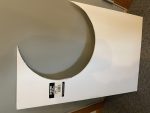
 Next is to line the can with an insulating material such as the plastic core board typically found at craft and hobby stores. Depending on your can size, I used two 3/8”x20”x 30” sheets for the bottom and sides. Using the bottom of the can, mark the circle and subtract maybe 1/2” and trim until it fits nice in the bottom. Before starting the sides, wipe down the inside and top lip of the can to remove oils, since this is where tape will be used.
Next is to line the can with an insulating material such as the plastic core board typically found at craft and hobby stores. Depending on your can size, I used two 3/8”x20”x 30” sheets for the bottom and sides. Using the bottom of the can, mark the circle and subtract maybe 1/2” and trim until it fits nice in the bottom. Before starting the sides, wipe down the inside and top lip of the can to remove oils, since this is where tape will be used.
For the side walls, that the foam board and lightly score lines about 1” apart and gently roll the board into a curved shape. Make about 3-4 pieces until the side walls are completely covered. You will note because of the taper of the can, the wall ends won’t match up. I simply overlapped the pieces, marked the overlapping edge and trimmed off that marked piece so there was no overlap cutting. The length of the side wall foam should leave about 4” of the metal can exposed. This is where the copper mesh will be applied.
Once the foam board is installed the can interior the copper shield (rodent mesh) needs to attached to the top of the can lid. Wipe the inside of the can rim with rubbing alcohol to remove any oils. Using the furnace tape, pull off about 12”-15” of tape but leave the sticky backer on. Cut a piece of the copper mesh about 1” longer than the tape. I found applying the copper to the tape in shorter pieces is much easier to manage than a 36” piece, all at once.
Pull off a couple inches of the backer tape and apply the copper mesh with one fold to the mesh. This will make the copper seal stronger and a better connection than a single layer. Begin to apply the tape / mesh combination moving around the rim and pulling the backer tape of simultaneously.
The completed Faraday enclosure should look something like the following, with the copper mesh protruding slightly above the rim of the can to electrically contact the lid for a good connection:
The interior should look like this:
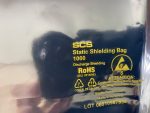 I place my electronics in anti-static bags that I had leftover from electronics purchases. But these can be purchased online from several sources. They are made of a metallic shiny-looking mylar plastic similar to the one shown. I believe they provide an additional layer of protection, if taped shut.
I place my electronics in anti-static bags that I had leftover from electronics purchases. But these can be purchased online from several sources. They are made of a metallic shiny-looking mylar plastic similar to the one shown. I believe they provide an additional layer of protection, if taped shut.
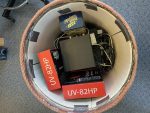 One of my completed “Poor Man’s” Faraday cans is now filled with spare amateur radios and equipment, (several handhelds, three base stations, a mini-computer, antenna analyzer, Signal Link, and Auto Tuner with cables). The steel Maxwell House coffee can shown holds a pocket shortwave radio.
One of my completed “Poor Man’s” Faraday cans is now filled with spare amateur radios and equipment, (several handhelds, three base stations, a mini-computer, antenna analyzer, Signal Link, and Auto Tuner with cables). The steel Maxwell House coffee can shown holds a pocket shortwave radio.
I hope this article will provide some ideas for those aware of the rarely discussed dangers of a CME and EMP and ways to help protect that spare equipment.

